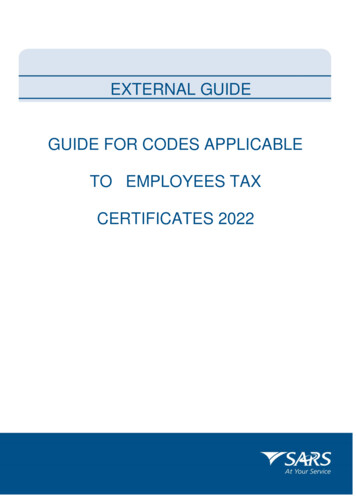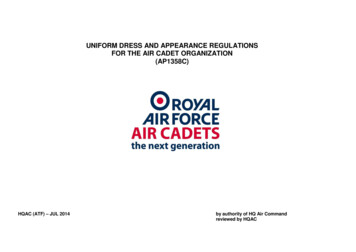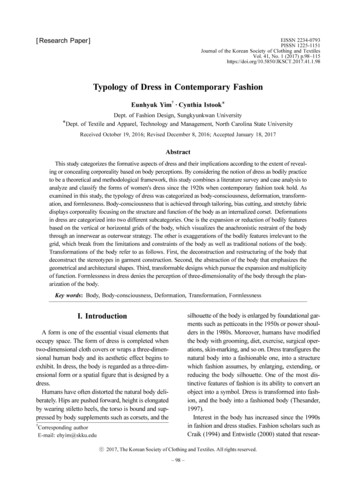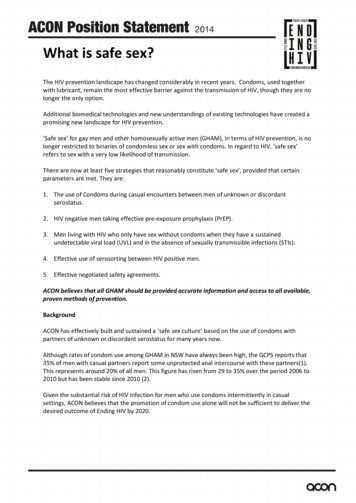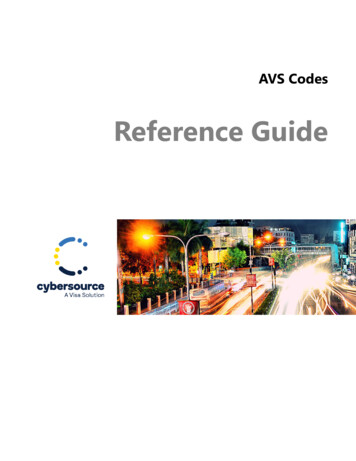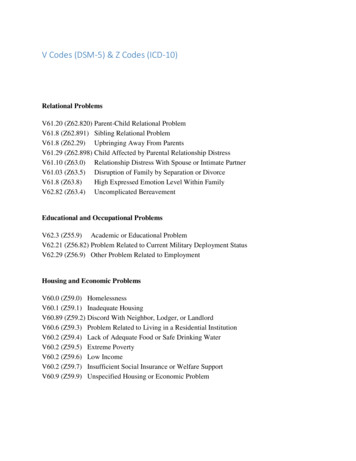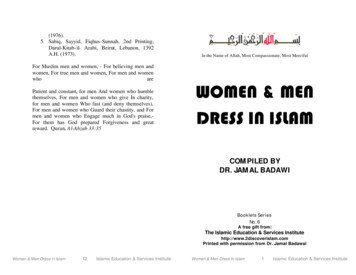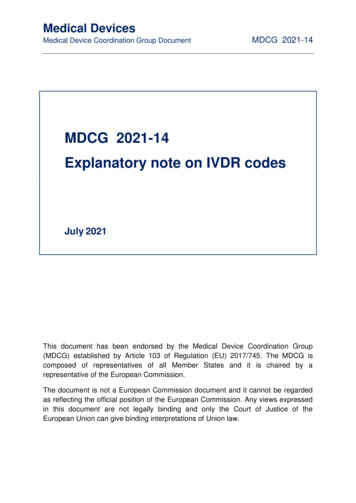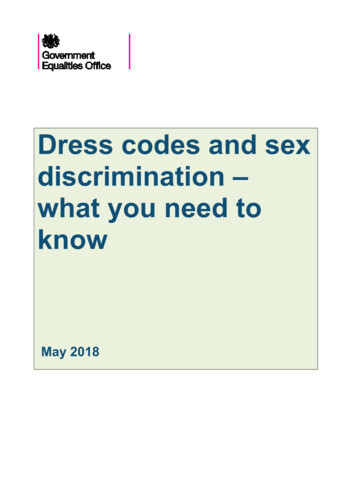
Transcription
Dress codes and sexdiscrimination –what you need toknowMay 2018
ContentsPageWho is this publication for?2Summary.2Introduction.2Setting a workplace dress code – your responsibilities as an employer.3Health and safety.3Reasonable adjustments for disabled employees.3Transgender staff.4Dress codes and religious symbols.4Dress codes – your rights as an employee.4Examples.5Frequently asked questions.6Further sources of information.71
Who is this publication for?This guidance is for employers who set dress codes and employees and job applicantswho may have to abide by them.Summary A workplace dress code is a set of standards that employers develop about whatis appropriate for employees to wear to work. Dress codes can be a legitimate part of an employer’s terms and conditions ofemployment. Dress policies for men and women do not have to be identical, but standardsimposed should be equivalent. Dress codes must not be a source of harassmentby colleagues or customers, for example women being expected to dress in aprovocative manner. It is best to avoid gender specific prescriptive requirements, for example therequirement to wear high heels. Any requirement to wear make-up, skirts, havemanicured nails, certain hairstyles or specific types of hosiery is likely to beunlawful (see further text on page 3). Consulting employees and trade unions over any proposed dress code or changesto an existing code will help ensure that the code is acceptable to both theorganisation and its staff.IntroductionThis guidance has been written following a recommendation from the ParliamentaryWomen and Equalities Select Committee and the Petitions Committee. It sets out howthe law might apply in cases of sex discrimination where an employer requires femalestaff to wear, for instance, high heels, make-up, hair of a particular length or style, orrevealing clothing.This guide explains the law on dress codes in workplaces such as offices, hotels, airlines,temporary work agencies, corporate services, the retail sector; and in the hospitalityindustry, especially in bars, restaurants and clubs. This is not an exhaustive list.The Equality Act 2010 (the Act) does not set out specific examples of practices that areunlawful, or definitions of behaviours that are ‘sexist’, ‘racist’ or ‘homophobic’ etc. It setsout the legal framework, including a ban on sex discrimination and harassment, and it isultimately for the courts to decide whether a practice is unlawful depending on the factsof each case.2
A dress code could be unlawful, for example, if it requires female employees to wear highheels, with all the discomfort and inherent health issues these can cause, because ittreats women less favourably than men.Setting a workplace dress code – your responsibilities as an employerDress codes can be a legitimate part of an employer’s terms and conditions of service.There are different ways of achieving a professional “look” among employees, but it isimportant that a dress code does not discriminate, for example, by allowing both men andwomen to wear trousers in the workplace.Dress policies for men and women do not have to be identical. However, the standardsimposed should be equivalent. This means there must be similar or equivalent rules laiddown for both male and female employees. Any less favourable treatment because ofsex could be direct discrimination. Dress codes must not lead to harassment bycolleagues or customers, so any requirements on women to dress in a provocativemanner are likely to be unlawful on those grounds.It is advisable to avoid gender specific prescriptive requirements. For example, anyrequirement to wear make-up, have manicured nails, wear hair in certain styles or towear specific types of hosiery or skirts is likely to be unlawful, assuming there is noequivalent requirement for men. A dress code that requires all employees to ‘dresssmartly’ would be lawful, provided the definition of ‘smart’ is reasonable. For example, atwo-piece suit in a similar colour for both men and women, with low-heeled shoes forboth sexes.It is good practice when setting or revising a dress code to consider the reasoning behindit. Consulting with employees, staff organisations and trade unions may better ensurethat the code is acceptable to both the organisation and staff. Once agreed it should becommunicated to all employees.Health and SafetyWhen setting a dress code, employers should have regard to any health and safetyimplications. For example, if an employer requires staff to wear particular shoes (as partof a dress code rather than for personal protective equipment purposes), then theyshould consider whether this may make staff more prone to slips and trips or injuries tothe feet.Reasonable adjustments for disabled employeesWhere someone meets the definition of a disabled person in the Act, employers arerequired to make reasonable adjustments to any elements of the job which place adisabled person at a substantial disadvantage compared to non-disabled people. This3
could include not applying dress code requirements, where their impact is more onerouson a disabled employee. See kersTransgender staffThere are some people whose gender identity (the gender with which they identify) doesnot match the gender they were assigned at birth – these are transgender people. Manywill undergo the process of aligning their life and physical identity to match their genderidentity, and this is called transitioning.Transgender employees should be allowed to follow the organisation’s dress code in away which they feel matches their gender identity. If there is a staff uniform, they shouldbe supplied with an option which suits them.Dress codes and religious symbolsBritain is an integrated and cohesive society with a proud tradition of religious tolerancewithin the law. Employers should be flexible and not set dress codes which prohibitreligious symbols that do not interfere with an employee’s work. New Acas guidance onReligion or Belief can be found at this link: (www.acas.org.uk/religionorbelief).Dress codes – your rights as an employeeIf you think that your employer’s dress code is discriminatory, speak to your manager inthe first instance, explaining the reasons. He or she should engage constructively withyour concern. If they react badly to your complaint, for example by criticising orpenalising you, this could be unlawful victimisation, which you are protected from underthe Equality Act 2010.If this approach does not resolve the issue, you can follow the HR processes for yourorganisation, or ask for help from your trade union representative. You can also contactthe Advisory, Conciliation and Arbitration Service or the Equality Advisory and SupportService (see page 6) if you think you have experienced discrimination. Ultimately, youmay take your case to an employment tribunal, but it is usually best to seek anagreement or compromise with your employer before this stage is reached.4
ExamplesAn employer requires female staff to wear high heels as part of a dress code butplaces no footwear requirements on men or merely requires them to look smart. This islikely to constitute direct discrimination on grounds of sex because there is not anequivalent standard imposed on male staff. It may also amount to indirectdiscrimination against employees with a disability, where heels could exacerbate anydifficulties with their mobility, or for those who are visually impaired, where walking inheels can pose an extra risk of falling.A company requires their receptionists to dress smartly, to portray a positive publicfacing image. This would be lawful, as there are no gender specific requirements formen or women.An employer requires all employees to wear smart shoes, but does not require femaleemployees to wear high heels. This would be lawful.A clothes shop expects staff, both male and female, to dress in a provocative orrevealing fashion. This might not amount to direct discrimination since it imposesequivalent requirements on men and women, but it could contribute to an environmentin which employees may be vulnerable to unwanted sexual attention andharassment.In the clothes shop example above, a female shop assistant makes a complaint thatthe dress code amounts to harassment. Shortly after, she is dismissed from her job,with no valid reason given. This is likely to constitute unlawful victimisation even ifthe employer did not say it was because of her complaint. This would be the caseeven if the shop assistant’s harassment complaint was not upheld.5
Frequently Asked QuestionsIs it lawful for an employer to set different dress codes for men and women?Dress codes must apply to both men and women but may have different requirements solong as these are of a similar standard, and not applied more strictly to one sex over theother. For example, a requirement for men to wear a shirt and tie is not unlawful if womenare also expected to wear smart office attire.Is it lawful for an employer to require female employees to wear high heels?It is likely to be unlawful under the Equality Act 2010 for employers to require women towear high heels, with the discomfort or health issues that may entail, and as there is nomale equivalent.Can I be fired just for making a complaint about a sexist dress code?No. The Equality Act 2010 provides protection from victimisation, meaning that you cannotbe legally dismissed or badly treated by an employer for bringing a complaint, even wherethe complaint is not subsequently upheld. If you experience victimisation, you can getadvice from your HR Department, or trade union representative, Acas or the EqualityAdvisory and Support Service (EASS). If it is not resolved, you can take your employer toan employment tribunal.How do I enforce my rights?If you think your employer or potential employer has discriminated against you in theirdress code or in any other way and you cannot resolve the issue informally, you shouldspeak to your HR Department or trade union representative if you have one, who willadvise you of your options. You can also apply for early conciliation at Acas, which youand your employer would attend. If this conciliation does not resolve the dispute, you maytake your case to an employment tribunal. If the tribunal upholds your claim, you may beentitled to compensation and repayment of any costs.Where can I find out information about work wear or jewellery that an employeemight ask to wear for religious reasons?If you decide you want to implement a dress code or uniform policy, you must ensure thatthis does not directly or indirectly discriminate against employees with a particular religionor belief or no religion or belief. The Equality and Human Rights Commission publishesguidance on dress codes and religious symbols, which can be found symbols6
Further sources of informationThe Advisory, Conciliation and Arbitration Service guidance on dress codes can be foundat:www.acas.org.uk/index.aspx?articleid 4953The Equality and Human Rights Commission provide guidance on sexist dress codeswhich can be found doThe Equality and Human Rights Commission provides guidance on avoidingdiscrimination in dress and business attire, within their Employment Statutory Code ofPractice (page wnload/employment-statutory-codepracticeTrade unions negotiate with employers for better workplace policies on dress codes.www.tuc.org.uk/Further guidance on supporting transgender staff has been issued by the employersand by Acas: www.acas.org.uk/index.aspx?articleid 2064Further information on slips and trips and musculoskeletal disorders can be found here:www.hse.gov.uk/slips www.hse.gov.uk/msd/msds.htmThere is support for individuals seeking information and advice on discrimination inemployment issues. Acas provides authoritative and impartial advice free to employeesor employers via their website (www.acas.org.uk ) and telephone helpline 0300 123 1100or text phone 18001 0300 123 1100.The Equality Advisory and Support Service also provides bespoke advice and in-depthsupport to individuals with discrimination problems by calling the following number 0808800 0082 or text phone 0808 800 0084. Individuals seeking independent legal advicecan contact their local Citizens Advice Bureau or Law Centre.7
Crown copyright 2018This publication (not including logos) is licensed under the terms of the OpenGovernment Licence v3.0 except where otherwise stated. Where we have identified anythird party copyright information you will need to obtain permission from the copyrightholders concerned.To view this ves.gsi.gov.ukwrite toInformation Policy Team, The National Archives, Kew, London, TW9 4DUAbout this publication:enquiries alities-officedownload www.gov.uk/government/publicationsFollow us on Twitter:https://twitter.com/WomenEqualitiesLike us on Facebook:www.facebook.com/GovtEquality8
advise you of your options. You can also apply for early conciliation at Acas, which you and your employer would attend. If this conciliation does not resolve the dispute, you may take your case to an employment tribunal. If the tribunal upholds your claim, you may be entitled to compensation and repayment of any costs.
